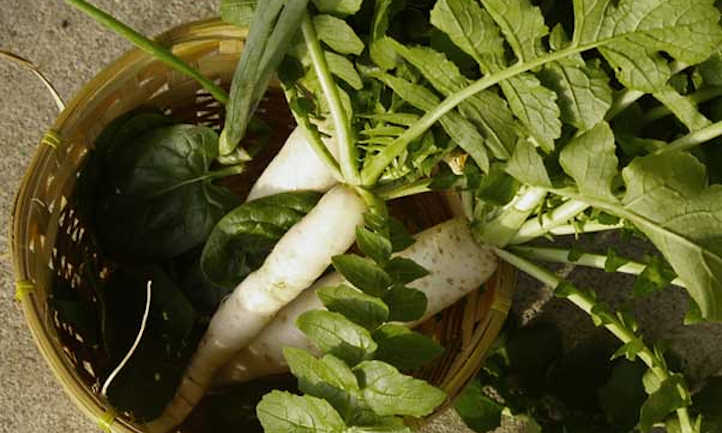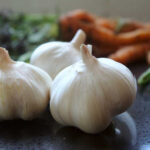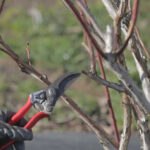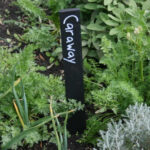Want a vegetable that is good for you and your garden? Growing daikon radish is the answer. Known for its long, icicle-like appearance and large flourishing leaves, a crop of daikon not only provides you and yours with healthy nutrients in a mild flavor profile but also breaks up compacted ground in your garden.
Daikon radishes, or Raphanus sativus var. longipinnatus, were first cultivated in East Asia — specifically Northern China. There are varieties native to Japan, India, Malaysia, and even Singapore. Today, Chinese radishes are used across cultures and continents as a comestible, and also as a cover crop to improve garden health. The taproot can dive deep into compacted soil and break it up for future crops.
Generally, daikon radishes are 1-2 pounds each. The biggest recorded daikon to date was grown in Kagoshima City, Japan, and weighed about 73 pounds! It was also over two feet wide! This particular variety, called Sakurajima, grows copiously in the volcanic region.
What is thought of as a typical variety of daikon doesn’t have the same shape, however, as the Sakurajima. Most varieties are cylindrical and have white skin, although there are many varieties with completely different characteristics. Leaves grow from the top of the root and can be eaten as well. It is consumed fresh, pickled, or cooked into soups and other dishes.
Daikon radishes are not hard to produce. Grow daikon in almost any region at the right time. After they have been planted and have a chance to loosen your garden bed, find you can put many other nightshades in their place.
Quick Care Guide
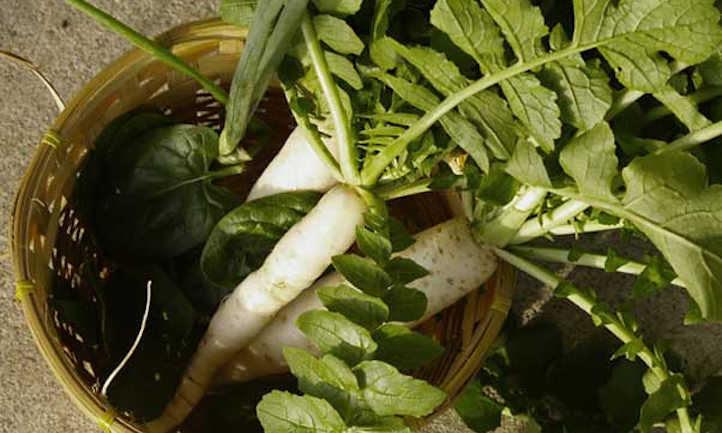
| Common Name(s) | Daikon, mooli, white radish, winter radish, chai tau, icicle radish |
| Scientific Name | Raphanus sativus var. longipinnatus |
| Days to Harvest | 30-80 days to maturity, depending on the variety |
| Light | Full sun to partial shade |
| Water: | Keep moist, but not wet |
| Soil | Well-draining, amended with compost up to 8 inches from the surface; pH of 5.8-6.8 |
| Fertilizer | Avoid high nitrogen fertilizers; full spectrum 2x/season is enough |
| Pests | Flea beetles, cutworms, cabbage loopers, aphids, harlequin beetles |
| Diseases | Black root, downy mildew, fusarium wilt, clubroot, alternaria blight, white rust, wirestem |
All About Daikon Radish
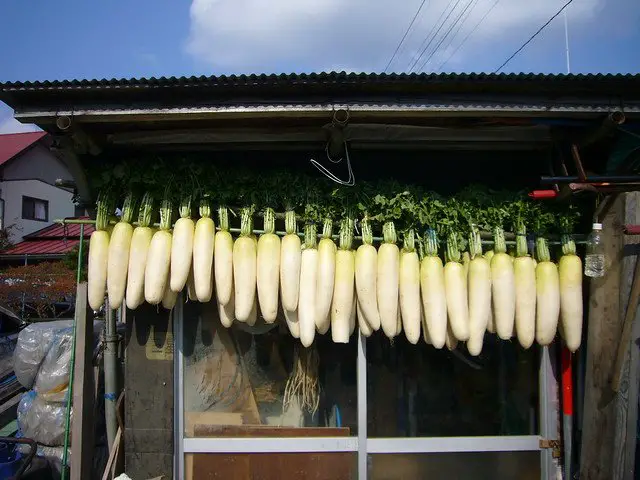
Raphanus sativus var. longipinnatus, daikon radishes are called mooli in India and the UK, and chai tau in Thailand and Taiwan. White radish, winter radish, and icicle radish are other names for this taproot. Daikon is a Chinese radish but was systematically introduced in surrounding countries where it is popular today. The name daikon is a Japanese word that means “big root”.
The daikon taproot ranges from pale white to a deep red depending on variety. To photosynthesize nutrients, daikon radishes have burgeoning leafy greens that radiate from the center of the root. If left to bolt, they grow a small seed pod that looks somewhat like a green bean (but much smaller). These are very mustardy in flavor, and can be added to salads or just eaten off the plant. Bolts eventually bloom into lovely white flowers. These characteristics indicate a huge flavor change. Daikon radishes that flower taste very bitter. Beware of eating them at this stage.
These plants are at their peak before the first frost, so seeds are sown in late summer or early fall. Spring plantings are too warm for daikon. Typically, they do not appreciate high heat. Sprouts have heart-shaped dicotyledons, and true leaves look more serrated. Over 30-80 days a mature taproot develops. The top of the taproot will be visible when the daikon is ready for harvest.
Although greens are used in cooking, the taproot is sought after most. Traditionally, daikon is chopped or julienned and pickled to serve as a fresh side with other food items. With such a mild flavor, it is favored as a raw addition to salads. It’s cooked into soups and simmered with chicken and greens. It’s thought that daikon radishes were grated and eaten raw beginning in the Edo period in Japan as a digestion aid.
My favorite variety of daikon is called Watermelon Radish. It has light green skin and a pink interior. Unlike the well-known cylindrical varieties, Watermelon radish is round and small. Its flavor is sweet and spicy, and it’s a great addition to any raw-cut vegetable platter you serve at a get-together. Whatever variety you choose, there are so many different shapes and sizes. And since there is a long history of daikon consumption in the world, there are tons of heirloom varieties to search for.
Planting Daikon Radishes
Sprouting this radish is simple, mostly because it’s such an easy-going plant. Wait until late summer or early fall (not spring) to sow seed directly in mildly amended media, like you would for any radish. Although many plants will do well in grow bags (Root Pouch is our preferred grow bag) or containers, daikon is not one of these.
You’ll need a wide depth to work with, so daikon seeds must be planted in an in-ground bed or a raised bed. That being said, you’ll have to grow daikon outdoors in a full to dapple sunlit area. To sow seed, create rows and drop seeds in. As seedlings grow, thin them out.
Care

Grow daikon radishes and watch them mature quickly. All you have to do is ensure you don’t over-fertilize while planting daikon. Roots then grow and loosen the earth below.
Sun and Temperature
Daikon loves to be planted in full sun to partial sun, with at least six hours per day. It grows in USDA hardiness zones 2-11 at temperatures of 50-65 degrees (which sometimes occurs up to October), although it can grow in colder weather as low as 30 degrees Fahrenheit. Once temperatures drop below 20 degrees, however, daikon radishes are in danger of termination. Alternatively, high heat in spring isn’t best for daikon. Like every radish (daikon included), daikons prefer to grow in temperatures below 80 degrees. High heat stunts radishes.
If you must grow daikon radishes when it might be too cold long after fall, try frost cloth to protect your crop until spring. The soil in a raised bed retains more heat than that of the ground. Here the likelihood of keeping the leaf color green and healthy in this situation is higher, but forcing these conditions can change the flavor of your plants.
Water and Humidity
In warm weather, water daikon radishes daily in the morning hours before ultraviolet sunrays have had time to get below the surface of the bed. By doing this, you ensure daikon is not stunted due to high heat. As the weather cools, check dampness to know when it’s time to provide more water. You want the earth to be moist but not wet. Stick your finger about one inch into the ground. If it is dry at this depth, add some water — but again, not until the morning hours.
The best type of irrigation for daikon is drip irrigation. A consistent drip of water during the morning hours will give radishes just the right amount of hydration. However, daikon does appreciate moderate to high humidity, so keep the bed moist and create the conditions that daikon radishes require.
Soil
Grow daikon in poor, compacted clay media, and roots will develop. But to thrive, radishes require a basic well-draining soil amended with compost. Most radishes prefer a pH of 5.8-6.8 for roots to form well enough to eat. Daikon does not do well in high nitrogen content soil, so test your soil ahead of time if that has been an issue before. A high nitrogen count will prevent radishes from forming at all. If retaining moisture is an issue, apply mulch around the base of each seedling.
Fertilizing
Daikon radish doesn’t need much fertilizer, especially in colder months when it is best not to fertilize at all. If you plant daikon in amended soil, it doesn’t need extra help. A compost tea fertilizer once the plant is established and halfway through the season won’t hurt.
Avoid high-nitrogen content fertilizers. Too much nitrogen in your soil or fertilizer stunts the roots’ growth in daikon and diverts production energy into the foliage. If you decide to use a commercial fertilizer, use those with a lower ratio of nitrogen compared to potassium and phosphorous content. Some even say no fertilizer is best.
Propagation
There is only one way to propagate daikon: by seed. Remember those pods we talked about earlier that appear when the daikon is overly mature? The ones that have a lovely mustardy flavor? Search for those, collect them in a paper bag. Once dry, the pods pop open and seeds are collected. Then plant them in the next growing season, by October. This process is particularly important for heirloom varieties, which rely on your ability to collect seeds for survival.
Harvesting and Storing

Like any other radish, daikon roots have a long shelf life. Although the daikon leaf may not hold up, the radish will keep for a long time. Harvest and store them correctly, and enjoy them long after harvest.
Harvesting
When the radish leaf reaches at least an 8-inch length in early winter, it’s time to harvest. This leaf length is also accompanied by the tops of the daikon roots peeking out from the soil. If you’re unsure about the readiness of these plants, it’s ok to pull one and see how many inches long or wide it is in comparison to the leaves. It is very important to harvest before heavy frost sets in, which causes root rot.
To harvest, simply grab the leaf bundles at the point where it meets the radish, and pull. If you have enough time before the first frost, and you notice the daikon are not as big as you would like, feel free to let the others remain. In your former daikon area, you now have a rich growing medium for other root and nightshade vegetables.
Storing
The green leaves of daikon can be eaten raw in salads or wilted, but only keep for a few days in the refrigerator. If the leaves are slightly wilted and salted, they’ll last in the freezer for up to one month. They can also be removed and composted as green matter. Overall, separating leaves and roots will help the radish keep longer.
To store the radish roots in the refrigerator, keep them in a plastic bag or wrapped in a damp towel. Too much longer in this state and the root will take on a woody texture. Since daikon is full of nutrients, pickle it in mason jars and store it year-round. Pickling the daikon allows certain harder-to-digest compounds to break down. Blanch the whole daikon briefly, chop it into large pieces to store in the freezer for up to one month. If daikon is sun-dried, it can last for up to 6 months.
Troubleshooting

Daikon is easy to work with under the right conditions. But it is susceptible to a variety of fungal conditions when it’s too cold and wet.
Growing Problems
High heat prevents root development in these plants. Daikons require warmth for seed germination, but they grow best when the weather cools. In hot weather, daikon tends to bolt. If you realize you’ve planted at the wrong time, try again next time! Allow bolts to form, and collect seed pods for the upcoming late summer planting phase.
If the weather is too cold, or too frosty for daikon, the roots will still develop, but your daikon crop will rot. Remember to pull daikon before the first frost date to keep the destruction at bay.
Too much water can also damage daikon roots. If you notice the soil is not drying properly, water less. Alternatively, too little water causes root crack and changes the flavor of your daikon. Mulch to reduce soil moisture evaporation.
Too much nitrogen diverts all the energy of these plants to leaf development rather than root development. Stop this from happening by measuring nutrients in your planting area with a soil test. Many higher education extension offices offer free kits. If you notice there’s been a repeat issue, test the soil before planting again.
Overcrowding prevents taproot formation in all radishes. Thin seedlings that sprout once their true leaves develop to at least a few inches apart, even though initially you sow one inch apart. Remember to keep rows at least 18 to 20 inches apart in the initial seed germination stage.
Pests
Daikon crops show signs of flea beetle infestation when small, webby round holes appear on leaves. Search for damage rather than the culprits themselves as flea beetle appearance varies greatly across species. To rid your crops of flea beetles, handpick them, or put down sticky traps that will attract and kill them. Diatomaceous earth sprinkled around the base of plants keeps flea beetles from entering. Apply pyrethrins if things get out of hand. Row covers also keep all insect enemies out of your plants.
Cutworms are another insect pest that daikon crops have to contend with to survive. They consume the base of plants to pupate and develop into a moth, which ironically does no damage in the garden. Prevent cutworms by creating a barrier around the base of seedlings that extends a few inches deep into the soil. If you notice them in your garden during the day, handpick them and dunk them into soapy water. If spraying is necessary, use BT (Bacillus thuringiensis) to prevent further damage.
Cabbage loopers eat the leaves of daikon, making it very difficult for nutrients to move toward root development. In addition, cabbage loopers consume leaves before they can reach maturity. If you have a thriving garden, birds, insects, and other animals prey on loopers, but BT, pyrethrins, and spinosad (a fungus-based pesticide) also eliminate cabbage loopers.
Aphids munch on daikon leaves before roots reach maturity too. Check the underside of radish leaves daily for signs of aphids. They are many different colors, but they have a similar appearance — tiny and round and plenty. Employ ladybugs who will munch down on these pests. Also, spray your plants with neem oil, which aphids hate.
Harlequin bugs (Murgantia histronica) are small stink bugs with a black and orange to red patterned shell. If you see them, hand-pick and remove them from plants before they mature. They overwinter in plants, so if you notice, frankly, really cool-looking black and white eggs on plants near your daikon crops, remove and destroy them before they hatch. Apply spinosad to control the proliferation of harlequin bugs.
Diseases
Black root (Aphanomyces raphani) is a fungal disease that rots radish roots and strikes when conditions are too wet. This occurs at any point in the radish life cycle. There is no way to treat black root, other than preventing the cool, wet conditions where it thrives. Remove and destroy infected produce. Do not compost.
Fusarium wilt (from the fungus, Fusarium oxysporum) is yet another fungus that occurs in overly cool and wet conditions. A few bacterial and mycological soil additives are proving to be helpful against fusarium, but prevention is best.
Clubroot (another fungal disease) affects radishes by mutating roots. If you notice stunted growth in your crops’ leaves, try pulling a daikon to see if it’s infected. Destroy damaged plants, do not compost them.
Downy mildew is another fungal disease that occurs in high-moisture or high-humidity conditions. While it can be treated using copper fungicides, it’s best to avoid it because it tends to be stubborn and doesn’t die out easily. Avoid composting material that’s colonized with downy mildew.
Alternaria blight is yet another pathogen that radishes have to deal with when proper growing conditions are not met. If leaves show brown spots, apply a liquid copper fungicide to prevent the spread of this highly infectious disease.
Similarly, white rust spores collect on leaves and can be treated with copper fungicide as well.
If you notice a dark spot right at the base of your daikon seedlings, it’s likely wirestem (Rhizoctonia solani) has set in. Wirestem turns seedling leaves a bluish color. Copper fungicides will work to treat already affected plants after they are transplanted.
Frequently Asked Questions
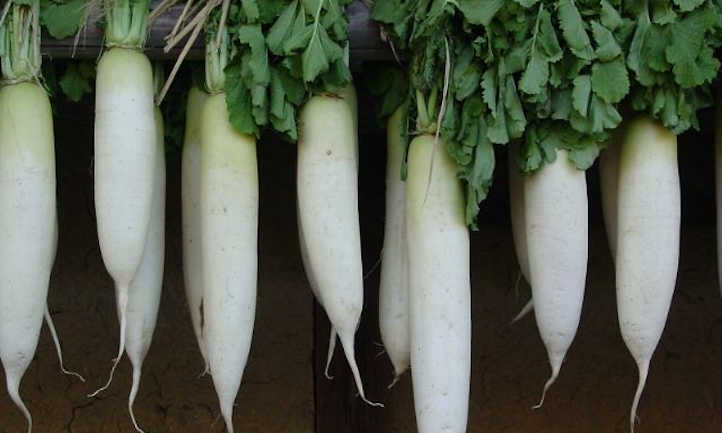
Q: How long does it take to grow daikon radish?
A: It depends on the variety. Some species take just 30 days to mature, and some take up to 80. Select a variety that suits your needs, and take into consideration the first projected frost date. This gives you an idea of how many days you have until daikon should be harvested.
Q: Can you regrow daikon radish?
A: Unfortunately once they have been harvested, daikon taproots cannot be regrown. If you enjoy the greens, however, they will continue to proliferate if replanted.
Q: Is daikon radish perennial?
A: Daikon radishes are annuals that enjoy increasingly cool soil temperatures in their maturation process. They will produce once per year near the first frost date.

